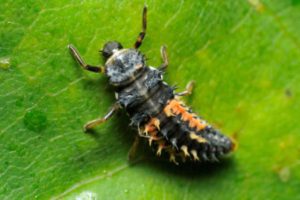LADY BEETLES ARE NOT ALWAYS WELL-BEHAVED
By Zachary Ciras on February 25, 2021.
Kids love them and most of us have good feelings about ladybugs, more correctly known as lady beetles. Technically these insects are not “bugs” but are instead members of a beetle family. In fact, our states of New Hampshire and Massachusetts have both chosen the lady beetle as their state insect. Several other states have also done so and New York went one step further, designating a particular species, the “nine-spotted lady beetle,” as its state insect. But anyone who has spent time with large numbers of lady beetles knows they are not always little darlings.
LADY BEETLES ARE BENEFICIAL INSECTS…MOSTLY

Harlequin ladybird (Harmonia axyridis) adult eating aphid.
Since lady beetle adults and their larvae both feed on other insects, most specifically aphids and those that attack plants, they are considered to be beneficial by farmers and gardeners. You may recall the planned introduction of the multicolored Asian lady beetles (Harmonia axyridis) into the U.S. a couple of decades ago. These beetles look much like our common red and black native lady beetles except that the Asian lady beetles come in different colors, mainly pumpkin orange, with differing numbers of black spots.
OUR FAVORITE BEETLE BECAME A HOUSEHOLD PEST
The imported Asian lady beetles did help to control crop pests, at least initially. However, it was not foreseen that these beneficial outside beetles would became seasonal inside nuisance pests as they moved into homes in the fall to spend the winter. For several years, different regions of the U.S. had to deal with lady beetles moving from crop fields into homes in the fall, sometimes by the thousands.
Once inside, the beetles generally went into hiding to wait out the winter. But even inside, they occasionally wandered about on warm winter days, sometimes staining surfaces, especially if swatted. Only later did we discover that they can also bite lightly if threatened and their dead bodies and feces sometimes trigger asthma or allergic reactions in sensitive individuals. Growers also were dismayed to find out that the imported multicolored Asian lady beetles sometimes damaged the very fruits they were supposed to protect by chewing into the skin and sucking juices (see When Did Ladybugs Get Attitude!).
Nevertheless, over the years we have either gotten used to our invading lady beetles or their behavior and numbers have changed. As happens with all insects introduced from another country, eventually they developed their own set of predators, parasites, and diseases that help keep their numbers in check. Today, most areas see both native lady beetle species (although fewer) and multicolored Asian lady beetles, although the native species are much less likely to move indoors.
OVERWINTERING INSECTS IN YOUR HOME WILL WAKE UP SOON!

Larva of a ladybug.
Lady beetles are just one of the groups of outdoor insects that move into homes in the fall seeking shelter for the winter. Others are seed bugs, boxelder bugs, elm leaf beetles, stink bugs, wasp queens, and cluster flies.
You may have some of these seasonal guests in your home right now and don’t even know it. But it won’t be long before the first warm early days of spring coax these overwintering insects out of hiding. Then you may see strange, sluggish insects wandering about or heading to windows in an attempt to get back outside.
WHAT CAN YOU DO ABOUT THESE UNWANTED WINTER GUESTS?
The time to prevent the seasonal invasion of overwintering insects like lady beetles is in late summer. At Colonial Pest, we apply a perimeter outside insecticide spray before the pests begin to move inside. Proper timing to intercept the invaders is important but you can leave that up to us if you are one of our Preventative Maintenance Program customers. Give us a call and ask how you can sign up.
There are also steps you can take to reduce fall-invading insects around your home. The most obvious is pest-proofing: screening, and caulking and sealing of gaps and openings that allow pests inside. Cleanup of wood and debris piles around the foundation helps, too.
For more on overwintering insects, see these Colonial blogs: